
Please note this is a work in progress. This page was last updated December 2012 - a new King Cobra episode has been added.
The King Cobra and The Menace in Pit 29 strips can be found at the bottom of this page.
Note - this page has been put together using information from articles and from a telephone conversation with the artist.

Ron Smith – brief biographical notes.
Note this article only covers Ron Smith’s early years up to the point he left D.C. Thomson.
Ronald George Smith, (Ron) Smith was born in Bournemouth, Dorset in 1924 and has worked in the comics industry all of his working life. Smith initially wanted to attend an art school, but at his father’s insistent, went to college to learn structural engineering. By 1943 Smith was in uniform with the Royal Air Force (RAF) learning to fly planes. By 1945 he was flying Spitfires for the Army Co-Operation Air Squadron.
Smith left the RAF in 1947 and found work with J. Arthur Rank’s Gaumont British Animation Studios. Here he found himself in his element and his employers were equally keen with his progress. Unfortunately, (but fortunately for comic fans), his time there was cut short as the studios went bankrupt in 1949.
He wasn’t out of work for long as he found employment drawing comic strips with Amalgamated Press (AP). Smith drew many Disney style cartoon strips for various AP comics such as Young Joey. He wanted though to branch out to draw other genre comics such as straight strips. The main reason being was that these artists were paid more and had more job opportunities. His first straight strip was The Flame and the Arrow, which wasn’t regarded as a high standard. Smith’s editor at this time at AP was Matthews.
‘ “He was very aggressive. He wouldn’t just say, “Ron, this drawing ain’t gonna make it.” He would actually put it on the floor and stand on it so that there was this vast print of a boot on it, to really push home that there was no way that he would print it.” ‘ (Book Magazine Collector, 200).
Smith continued to learn his trade providing artwork for Zane Grey’s Buffalo Stampede, The Last Outpost and Kit Carson. Towards the end of 1952 Ron was lured away from AP to work for D.C. Thomson with an offer of a house and a permanent contract. Thus began the artist’s twenty-one year association with D.C. Thomson. His house was situated across the River Tay looking towards Dundee and from there he drew strips for Adventure, Bunty, Beezer, Topper, The Hotspur and other comic titles. Smith only drew one strip (alas only the one), for the Victor, The Menace in Pit 19. (Three episodes have been posted below). As far as I am aware he didn't draw any strips for the Hornet comic.
D.C. Thomson's in Ron's day were very keen that their artists should not be allowed to mingle with other artists or moonlight for other companies. (Sounds as though the Security Services could learn alot from the publishing company!) This was the reason why Smith found himself living across the River Tay opposite the city of Dundee. The only time he visited Thomson's main building in Dundee was to hand in finished artwork. The inside of the the building was not open plan, so individuals and small groups of people occupied small rooms. Smith was never introduced to other artists or writers and could possibly have passed them without knowing who they were or they him.
In addition to drawing artwork for strips, Smith would also draw sketches which he would take to R.D. Lowe, D.C. Thomson's main editor. Lowe would then select the best of the sketches and if a story could be constructed around the sketch(es), they would be handed onto the writers.
Smith tells an amusing story about him taking a number of whisky bottles one Christmas, into various Thomson comics editorial offices. By the afternoon the whisky had been drunk and there wasn't much work going on. Thomson's is very strict about no drinking on the premises and Smith found himself being ticked off by Lowe for his generous christmas gesture.
Smith worked for D.C. Thomson for twenty-one years (1951 to 1972). Smith had left D.C. Thomson employment to work as a freelance comic artist. Although he occasionally found himself working for his old employer in drawing two characters he was particularly fond of Nick Jolly and the ‘superhero’ King Cobra. (Two adventures of this hero are available for you to read at the bottom of this page). Nick Jolly was an 18th century highwayman who found himself transported through time to the present day. Black Bess Jolly’s horse was replaced by a jet-propelled horse of steel. Smith described King Cobra as, “Spiderman with fangs.” Readers loved both of the characters. Both appeared in The Hotspur. When I spoke to Ron he mentioned that he had drawn several issues of Spiderman for Marvel Comics. This he did whilst still under contract with D.C. Thomson. He had to ensure that his name didn't appear on any of the artwork. What isn't clear though is which issues he drew, whether they were the American comics or possibly the British versions.
Other noteable artwork Smith drew included a Captain Caution leaflet for the now defunct British Rail (BR) featuring a superhero who cautioned young boys to stay away from playing or trespassing on the railway. A very sensible message that still applies today. An example of one of the leaflets is below with the unmistakable Smith artwork.
Smith has altered the British Rail logo to make it more flashier. (A pity BR didn't adopt the new logo). Captain Caution's costume is very colourful incorporating the BR colours of blue and yellow. But the top half of his costume is mostly red. We are all taught or learn through experience that red usually means danger, be aware, stay away. And Caution's costume helps to reinforce the leaflet's message. Nice to see that the Captain has no cape. A definite no, no if you work on the railways. Capes (or any loose clothing for that matter), can easily get snagged on a moving train or wagon with terminal consequences. What is a matter for concern for the Captain though would be his flying near or under overhead railway powerlines. He could find himself being attracted onto the wires by the electricity and then electrocuted! Our superhero's power source which possibly allows Caution to fly could possibly be his gold coloured waist belt. This is similar in design to the waist belt worn by another superhero, Wally Wood's 1960's character Dynamo of T.H.U.N.D.E.R. AGENTS. I'm not sure how many BR safety leaflets Smith drew, whether it was a series or just the above one. The exact date of the leaflet also isn't known. It possibly dates back to the 1980's, but this needs to be confirmed.
He also created the Green Cross Code Man for the Department of Transport. (These one page strips I recall seeing in boys comics. When I locate a page I'll post an example).
Ron Smith was happy to draw any type of story and genre except World War Two stories. And especially anything to do with WW2 areoplanes. He had been a spitfire pilot in the last year of the world wide conflict and he was fed up with the war.
Smith used black indian ink and drew his strips on Bristol board. He drew his artwork at a large card table. Whilst at D.C. Thomson's he had to use cross hatching because of the rough paper. For this he used a mapping nib. Once printing styles had changed he drew with brushes. He was influenced by the American artist Alex Raymond of Rip Kirby strip fame.
Smith was a fast worker and began work at 05.30 everyday Monday to Friday and usually finished his day at 18:00. He produced six pages a week. He rarely worked weekends. When he began to colour his strips, his output dropped to four pages a week.
Artists in the sixtes had to be aware of the Watch Committees, which were local to each city in the United Kingdom. What might be allowed in one city, might not be tolorated in another city. They had to be especially careful of how bullets killed people in comics. It wasn't possible for example, to show a bullet entering a human body or exiting it. How things have changed in today's comics.
Today's comic readers though remember Smith for his artwork for 2000AD and drawing one of its most popular characters Judge Dredd. I wonder whatever happened to that comic and character?!
These days Ron is enjoying his retirement. He doesn't draw anymore because of poor eyesight. Thank you Ron for all your hard work in providing comic fans with so many happy memories of your artwork over the decades.
Bibliography.
Book and Magazine Collector.- Sept. 2008.- issue 298.- pages 80 to 97.- ill. b+w, col.-
Judge Dredd Megazines issues 288 (Sept. 2009) and 289 (Oct. 2009).-
Below are several examples of some of Smith's comic output whilst he worked for D.C. Thomson.
The Menace in Pit 19.
Writer:-Victor Editorial team? Artist:- Ron Smith.
The following episodes of The Menace in Pit 19 are from issues 29, 31 and 36.



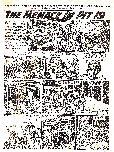 |
 |
 |
 |
 |
 |
The following adventures of King Cobra are from the Hotspur issues 912, 913 and 1000.
 |
 |
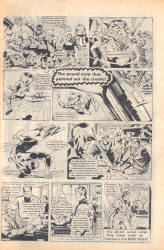 |
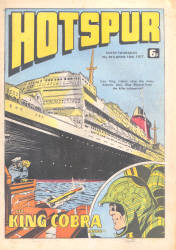 |
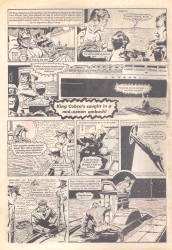 |
 |
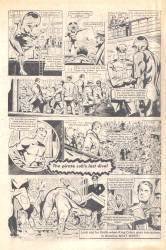 |
 |
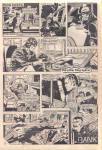 |
 |
 |
Further examples of Smith's early work for Thomson's New Hotspur comic is below. A colour front/back story from issue 171 and an American War of Independence front back cover story, from the Hotspur second series, number 397.
 |
 |
 |
 |
 Back to Victor strip reviews page. |
 Back to this site's home page. |
 Back to articles page. |
Acknowledgements
My thanks to the artist Ron Smith and Matt Smith (no relation), at the 2000AD nerve centre for providing an introduction to Mr. Smith.
© Adrian Banfield, 2010.